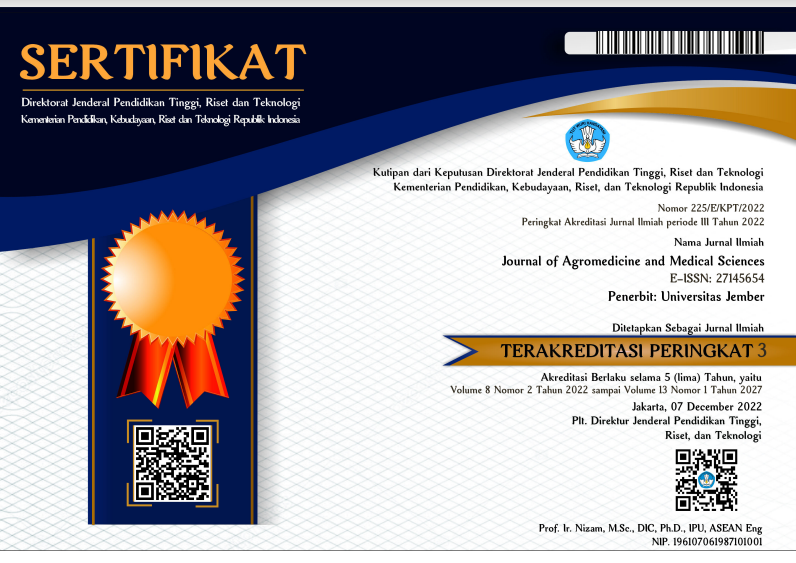Severe Deficit in Energy and Protein Intake Correlates wih Stunting among Children Aged 12-24 Months in Plerean Sumberjambe Jember
DOI:
https://doi.org/10.19184/ams.v7i2.24828Abstract
The current nutritional problems are still the world's attention, especially in developing countries, including Indonesia. The Global Nutrition Report shows that Indonesia is a country with three main nutritional problems: wasting, overweight, and stunting (under five) in infants. Stunting has short-term and long-term effects associated with growth and developmental disorders. This study wants to determine the correlation between energy and protein intake of children aged 12-24 months in Plerean, Sumberjambe, Jember. This is an observational research with cross sectional study design. The population of this study were all children aged 12-24 months in Plerean Village, Sumberjambe, Jember. A total of 48 parents/respondents were interviewed about the consumption history of the on the previous day. This is done to determine the energy and protein intake consumed by the research subjects. Measurement of energy and protein intake using 24-hours food recall method and stunting was obtained from secondary data obtained from Puskesmas Sumberjambe. This research used purposive sampling method. The data obtained is then converted into calorie units and processed using a statistical program. The results showed showed 28 subjects were male. Most parents of research subjects earn less than the Minimum Wage District (UMK). A total of 68.75% of subjects had severe deficit in energy intake. A total of 52.08% of subjects had a severe deficit protein. Using Spearman correlation test the correlation of energy intake with the incidence of stunting obtained p value = 0.000 with correlation coefficient -0.589. Then, the relationship of protein intake with the incidence of stunting obtained p = 0.001 with a correlation coefficient of -0.446. So it can be concluded that severe deficit in energy and protein intake correlates with stunting in the study subjects.
Keywords: 24-hours food recall, Energy, Protein, Stunting
Downloads
References
Balitbang Kemenkes RI, (2013). Riset Kesehatan Dasar, RISKESDAS 2013. Jakarta: Balitbang Kemenkes RI.
Bourrin S., Ammann, P., Bonjour, J. P., dan Rizzoli, R. (2000). Dietary protein restriction lowers plasma insulin-like growth factor i (IGF-I), impairs cortical bone formation, and induces osteoblastic resistance to IGF-I in adult female rats. Endocrinology. 141(9): 3149-3155. doi: 10.1210/endo.141.9.7633
Burckhardt, P., Dawson, H. B., dan Weaver, C. M. (2010). Nutritional Influences on Bone Health. New York: Springer.
Dewi, I. A. K. C., dan Adhi, K. T. (2016). Pengaruh konsumsi protein dan seng serta riwayat penyakit infeksi terhadap kejadian stunting pada anak balita umur 24-59 bulan Di Wilayah Kerja Puskesmas Nusa Penida III. Arc.Com.Health. 3(1): 36-46.
https://ojs.unud.ac.id/index.php/ach/article/view/21077
Dinas Kesehatan Jember. (2017). Data Operasi Timbang Balita Tahun 2017. Jember: Dinas Kesehatan Kabupaten Jember.
Hardinsyah, H. Riyadi, dan V. Napitulu. (2012). Kecukupan energi protein, lemak dan karbohidrat. Skripsi. Bogor: Departemen Gizi Masyarakat Fakultas Ekologi Manusia Institut Pertanian Bogor.
Kemenkes RI. (2012). Penuhi Kebutuhan Gizi pada 1000 Hari Pertama Kehidupan. Jakarta: Kementerian Kesehatan RI.
Kemenkes RI (Pusat Data dan Informasi Kementerian Kesehatan RI). (2016). Situasi Balita Pendek. Jakarta Selatan: Kementerian Kesehatan RI.
Linder, M. C. (2010). Biokimia Nutrisi dan Metabolisme. Jakarta: Universitas Indonesia (UI-Press).
Mamabolo, R.L., Alberts, M. Steyn, N.P., Waal, H. A. D. D., dan Levitt, N. S. 2005. Prevalence and Determinats of Stunting and Overweight in 3 Year Old Black South African Children Residing in the Central Region of Limpopo Province, South Africa. Public Health Nutrition. 8(5): 501-508. DOI: 10.1079/phn2005786
Millward, D. J. (2017). Nutrition, infection and stunting: the roles of deficiencies of individual nutrients and foods, and of inflammation, as determinants of reduced linear growth children. Nutrition Research Reviews. 30(1): 50-72. doi: 10.1017/S0954422416000238
Nadiyah, Briawan, D., dan Martianto, D. 2014. Faktor Risiko Stunting pada Anak Usia 0-23 Bulan di Provinsi Bali, Jawa Barat, dan Nusa Tenggara Timur. Jurnal Gizi dan Pangan. 9(2): 125-132. https://doi.org/10.25182/jgp.2014.9.2.%25p
Peraturan Menteri Kesehatan RI Nomor: 1995/MENKES/SK/XII/2010 Standar Antropometri Penilaian Status Gizi Anak. 30 Desember 2010. Jakarta: Direktorat Bina Gizi dan Kesehatan Ibu dan Anak Kementrian Kesehatan RI.
Regar, E., Sekartini, R. 2013. Hubungan Kecukupan Asupan Energi dan Makronutrien dengan Status Gizi Anak Usia 5-7 Tahun di Kelurahan Kampung Melayu, Jakarta Timur. eJournal Kedokteran Indonesia. 1(3): 184-189. https://doi.org/10.23886/ejki.1.3001.
Samuel, H. W. Subagio, dan Suhartono. (2017). Perbedaan Pola Konsumsi Dan Asupan Zat Gizi Anak Stunting Dan Tidak Stunting Usia 12 – 23 Bulan. UPPM Poltekkes Kemenkes Tasikmalaya. 13(2): 1-6. https://doi.org/10.37160/bmi.v13i1.84
Semba, R. D., de Pee S., Sun K., Sari M., Akhter N., dan Bloem M. W. 2008. Effect of Parental Formal Education on Risk of Child Stunting In Indonesia and Bangladesh: A Cross-Sectional Study. The Lancet. 371(9609): 322-328. DOI: 10.1016/s0140-6736(08)60169-5
Shrimpton, R., Victoria, C. G., Onis, M. D., Lima, R. C., Blossner, M., dan Clugston, G. 2001. Worldwide timing of growth faltering: implications for nutritional interventions. Pediatrics. 107(5): 1-7. DOI: 10.1542/peds.107.5.e75
Solihin, R. D. M., F. Anwar, dan D. Sukandar. 2013. Kaitan antara status gizi, perkembangan motorik dan sensorik pada anak usia prasekolah. Penelitian Gizi dan Makanan. 36(1): 62-72. http://ejournal.litbang.kemkes.go.id/index.php/pgm/article/view/3396
Sulistya, H. K., dan Sunarto. 2013. Hubungan Tingkat Asupan Energi dan Protein dengan Kejadian Gizi Kurang Anak Usia 2-5 Tahun. Jurnal Gizi Universitas Muhammadiyah Semarang. 2(1). 25-30 https://doi.org/10.26714/jg.2.1.2013.%25p
Sundari, E., dan Nuryanto. 2016. Hubungan Asupan Protein, Seng, Zat Besi, dan Riwayat Penyakit Infeksi dengan Z-Score TB/U pada Balita. Journal of Nutrition College. 5(4): 520-529.
https://doi.org/10.14710/jnc.v5i4.16468
Vaozia, S., dan Nuryanto. 2016. Faktor Risiko Kejadian Stunting pada Anak Usia 1-3 Tahun (Studi di Desa Menduran Kecamatan Brati Kabupaten Grobogan). Journal of Nutrition College. 5(4): 314-320. https://doi.org/10.14710/jnc.v5i4.16426
Wamani, H., Astrom, A. N., Peterson, S., Tumwine, J. K., dan Tylleskar, T. 2007. Boys Are More Stunted than Girls in Sub-Saharan Africa: A Meta-Analysis of 16 Demographic and Health Surveys. BMC Pediatrics. 7(17): 1471-2431. https://doi.org/10.1186/1471-2431-7-17
Wasaraka, Y. N. K., Prawirohartono, E. P., dan Soenarto, Y. 2015. Perbedaan Proporsi Stunting pada Anak Usia 12-24 Bulan Berdasarkan Pemanfaatan Pelayanan Posyandu di Kabupaten Jayapura, Papua. Jurnal Gizi Klinik Indonesia. 12(2): 72-78. https://doi.org/10.22146/ijcn.23305
Wellina, W. F., Kartasurya, M. I., dan Rahfilludin M. Z. 2016. Faktor Risiko Stunting pada Anak Umur 12-24 Bulan. Jurnal Gizi Indonesia. 5(1): 55-61. https://doi.org/10.14710/jgi.5.1.55-61
WHO. 2013. Childhood Stunting: Context, Causes and Consequences; WHO Conceptual Framework.
http://www.who.int/nutrition/events/2013_ChildhoodStunting_colloquium_14Oct_ConceptualFramework_colour.pdf. [Diakses pada Desember 2017].
Yablonski, G. G., dan Phillip, M. 2015. Nutritionally-Induced Catch Up Growth. Nutrients. 7(1): 517-551. doi: 10.3390/nu7010517
Yuliana, Y., & Sidiartha, I. (2015). Association Between Energy And Macronutrients Intake With Anthropometric Indicators In Children. Medicina, 45(1). Retrieved from https://ojs.unud.ac.id/index.php/medicina/article/view/13278























